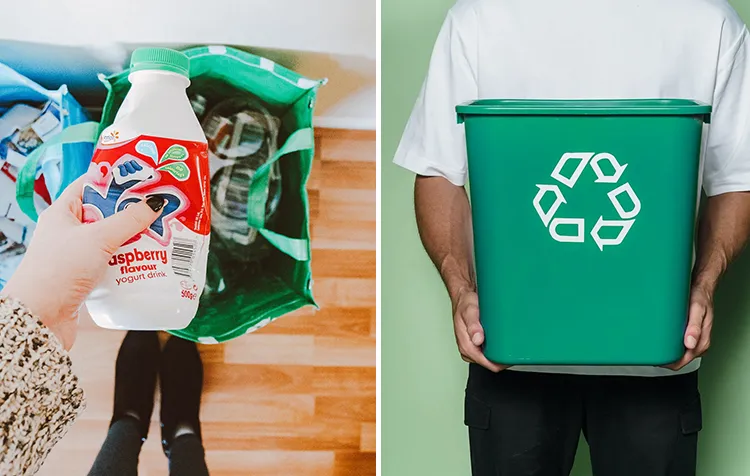Are you looking for relevant recycling statistics and the latest facts on waste recycling? Then you've come to the right place! Every day, we generate huge amounts of waste that pushes the capacities of recycling centers and landfills to their limits. Our consumer and Disposable society, the Growing world populationThe ecological challenges of our time and the planet's limited resources make the extraction of raw materials from waste and their processing into new products indispensable.
In this article, I would therefore like to introduce you to the most important global and national recycling figures. From plastic and paper to glass, organic waste, metal, electronics and textiles. I'll also introduce you to some remarkable facts that might surprise you. Let's go!
You can find a brief overview here in advance:
My please: If you use any of the recycling statistics from this post on the internet, please share the link of this post as a further source. Thank you very much for your support!
Plastics: current recycling statistics for plastics and packaging recycling
When we talk about waste management and recycling, it is Plastic often the first material that comes to mind. Especially Packaging and disposable materials made of plastic often end up as waste in nature and remain there forever because they are not biodegradable.
Here are some recycling statistics you should know around plastic recycling:
- Germany: According to the Federal Environment Agency, 99.4% of the 5.7 million tons of plastic waste in Germany was recycled in 2021. Around 64% for energy, 34% for materials and 0.4% for raw materials.₁
- Recycling rate: The recycling rate for waste from plastics production and plastics processing was 83% and 73% respectively in 2021. 29% of plastic waste from private households was recycled. For plastic waste from commercial end use, the figure was 38%.₁
- Exports: Plastic waste that is exported from Germany to certified recycling plants abroad is also considered recycled. Around 10 percent of the plastic waste generated in Germany was exported in 2022.₂
- Worldwide: The global recycling rate for plastic packaging is only 14%. Around 40 percent of packaging materials end up in landfills and 14 percent in incineration plants. According to the Heinrich Böll Foundation, the remaining 32% remains in the environment.₃
Tip: Deeper Statistics on plastic waste can be found in the linked article. Also about how you can Making life plastic free I have written a separate article for you.
Paper: Current recycling statistics on the recycling of waste paper
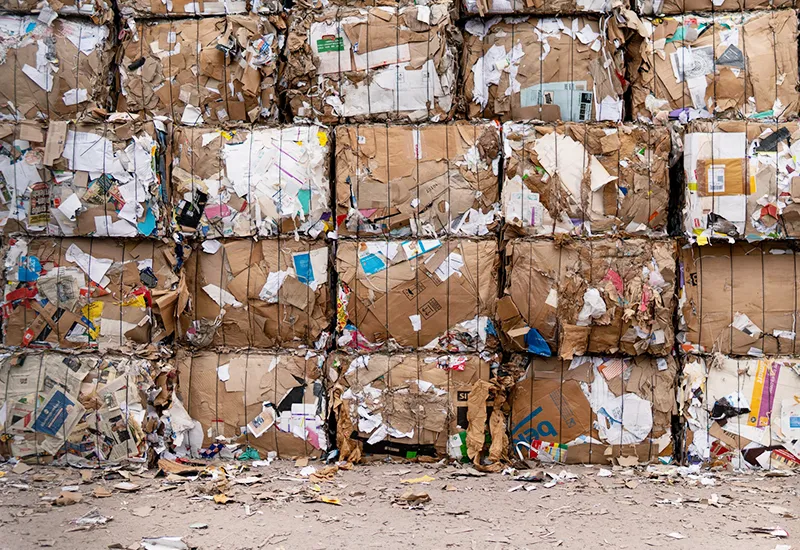
Whether Toilet paper, newspapers, shipping boxes or copy paper - Paper is a ubiquitous material in our everyday lives. Recycling it as efficiently as possible and favoring recycled paper (see sustainable printing), for example, plays a decisive role in protecting the forest stand and ensuring the Reduce CO2 emissions.
The following statistics give you a rough overview of paper recycling:
- Germany: The recycling rate for cardboard and paper packaging in Germany was 99.8% in 2019. It has never been lower than 99.4% since 2011.₄
- Worldwide: The global recycling rate for paper was around 74% in 2020.₅
- Value: It is estimated that the global paper recycling market will be worth around 50.75 trillion US dollars in 2023.₆
Tip: How you save paper in everyday life and how you can create the best possible Making the paperless office a reality can be found in the linked articles in the blog.
Glass: Current recycling statistics for the recycling of waste glass
In fact, used glass is the most important raw material for new glass packaging. Fortunately, if the material is disposed of properly (in the right glass containers), it can be can be recycled as often as desired.
Here are some of the key statistics on glass recycling:
- Germany: The recycling rate for glass from used packaging in Germany is 84.2%.₇
- Differences: The proportion of used glass in glass production today reaches up to 90 percent (depending on the color).₇
- Worldwide: Globally, the recycling rate for glass is around 21%. The rates for container glass are around 32% and for flat glass around 11%.₈
- Value: The global glass recycling market was estimated to be worth around 3,529 million dollars in 2017.₉
Tip: Is the Plastic bottle or glass bottle for mineral water more environmentally friendly? The linked article will give you the answer!
Organic waste: Current recycling statistics on the recycling of organic waste
Organic waste is an often underestimated part of our waste that has enormous potential for sustainable circular economy offers. Composting or recycling into biogas, for example, help us to conserve natural resources. Conserve the earth's resources.
- Germany: A total of 97% of all organic waste accepted at waste disposal facilities was recycled in 2020.₁₀
- Compost: During this period, 66.8% of the organic waste produced was reused in agriculture and forestry (e.g. horticulture or viticulture). Around 21 percent was recycled directly by private households and around 12 percent for landscaping and maintenance.₁₀
Tip: How you can change your Composting organic waste correctlyI will also explain in a separate blog post.
Metal: Current recycling statistics for the recycling of metals
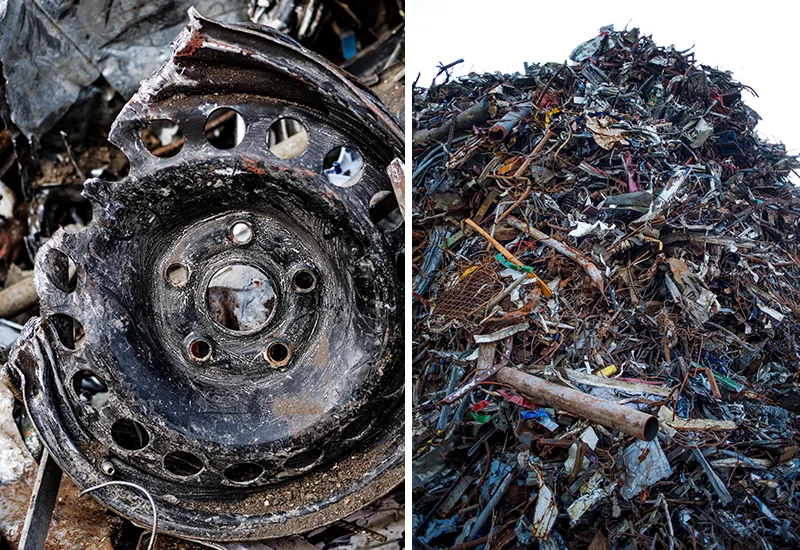
Metals are very difficult to handle due to their Consistency in the recycling cycle is essential. The recycling of aluminum, steel, copper and other metals massively reduces energy consumption in production and therefore also helps to save energy. biggest environmental problems of our time, such as the climate change, to counteract.
Here are some recycling statistics that give you a rough overview of the current recycling of metals:
- Aluminum: In 2021, around 53% of refined aluminum in Germany was produced from recycled material.₁₁
- Steel and copper: Around 45% of crude steel and 38% of copper in Germany also came from recycled raw materials in 2021.₁₁₁
- Worldwide: Globally, around 86 percent of gold, 60 percent of platinum, 50 percent of silver, 46 percent of copper, 42 percent of aluminum and 32 percent of cobalt are recycled.₁₂
Tip: Did you know that cell phones, for example, contain critical metals? At rare earths in smartphones you can find out more about this now. Also the article on how to save aluminum in everyday life I would like to take this opportunity to recommend this to you.
Electronics: Current recycling statistics for the recycling of electronic waste
Whether Refrigerator, washing machine, stove, TV, laptop or smartphone - Electronic devices are an ever-growing, essential part of our everyday lives. Above all, the valuable, limited resources available from electrical appliances make their recycling so important.
Here I have compiled some data and figures to give you an overview of the recycling of electronics in Germany and around the world:
- Germany: According to waste management companies, the recycling rate for electronic waste in Germany is over 50%. This means that more than half of old electronic devices are returned to the materials cycle.₁₃
- Worldwide: Only 17.4 percent of the world's electronic waste is recycled. Around 82.6 percent simply ends up in landfills or is incinerated.₁₃
- Value: The raw materials recycled from electronic waste worldwide have an estimated value of around 10 billion US dollars.₁₄
Tip: How you Dispose of electronic waste correctlyso that it can be recycled as completely as possible, can be found in the linked blog post.
Textiles: Current recycling statistics for the recycling of clothing and textile materials
The so-called Fast Fashion poses particularly great challenges for textile recycling, since quasi every week a new trend issued and masses of further, cheap fashion is produced.
Here are some recycling statistics about the textile industry that might interest you:
- New clothes: In that year, only around one percent of the textile fibers produced worldwide for clothing were recycled into new clothing.₁₅
- Disposal: Around 73 percent of used clothing produced worldwide ends up in landfills or waste incineration plants.₁₅
- Cleaning rags: Around 12 percent of textile waste is reprocessed into low-value products such as cleaning cloths.₁₅
- Germany: In Germany, around 62% of used textiles are reused as second-hand clothing. Around 14% is processed into low-value products and insulating materials. Around 12 percent goes into fiber recycling.₁₆
Tip: The so-called Slow Fashion is a decelerating countermovement to fast fashion. Use for example also the Tips for longer-lasting fashionso that your clothes last as long as possible.
Studies: The most important studies on the subject of recycling
You can find the sources for the statistics on waste recycling mentioned at the end of this article, but I would like to give you a few more studies in which you can more facts and figures find. Use them to gain even deeper insights into the complexity and progress of recycling in Germany and around the world.
- United Nations Institute for Training and Research (UNITAR): Global E-Waste Monitor
- Federal Ministry for the Environment, Nature Conservation, Nuclear Safety and Consumer Protection (BMUV): Waste management in Germany 2023 - facts, data, graphics
- ifeu - Institute for Energy and Environmental Research Heidelberg: Secondary raw materials in Germany
Do you know of any other important studiesthat make the current state and opportunities through the recycling of raw materials more tangible? Then I look forward to your comment.
The 10 most remarkable recycling facts that might surprise you
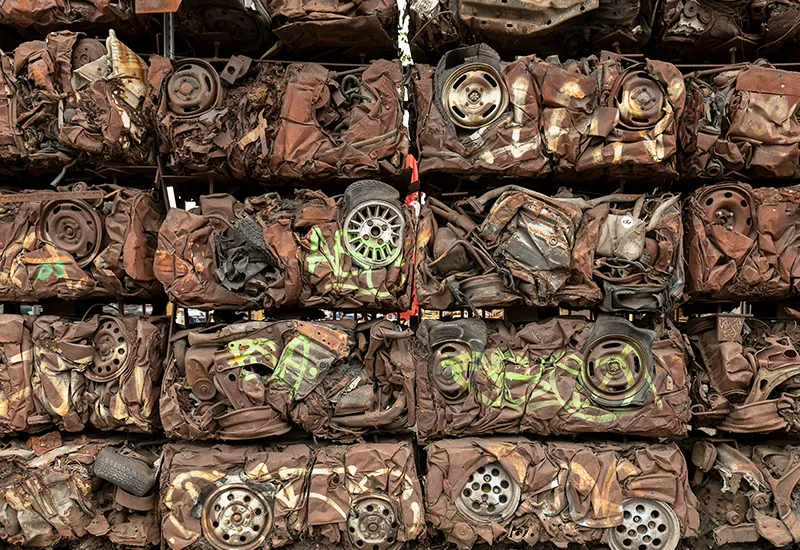
You have now seen some recycling statistics. They open your eyes to the dimensions and the enormous potential that lies in the recycling of raw materials. But now I would like to tell you pretty amazing facts name, which are thought-provoking and which promote the development to a sustainable lifestyle can promote.
1. metal is probably the oldest recycled material in the world
Anyone researching the history of recycling quickly realizes that it already begins in antiquity. Archaeologists have shown that, in addition to glass, metal was already being collected, melted down and reworked back then.₁₇
The appreciation for the material, recycling and the metal cycle is thereforealready many centuries old.Metals like iron and steelare therefore generally regarded as probably the oldest recycled materials in the world.
2. over 200 million old cell phones are stored in German households
As the figures show, we Germans are generally quite reluctant to part with our old smartphones. Over 200 million devices are still hoarded in households.₁₈
Converted therefore owns about each:r inhabitant:in 2.5 smartphoneswhose materials represent a valuable source of raw materials and could prevent the dangerous and environmentally damaging extraction of new raw materials.
Tip: By getting a buy a used smartphoneIf your old one is broken, you can also prevent other rare metals from having to be mined for you.
3. recycled plastics reduce greenhouse gas emissions by up to 60 percent
The use of recycled plastics can reduce climate-damaging greenhouse gas emissions by up to 60 percent.₁₉ Those who use the Promoting climate protection in everyday life therefore should always Return old items to the recycling loop.
4. our waste is enough to cover the entire planet 24 times over
Lined up end to end, the amount of waste we humans produce around the world every year would reach around the entire planet 24 times.₂₀ An impressive fact that makes the The extent of our "affluent society" Don't you think? Use it, for example, as motivation to get your further reduce our ecological footprint.
5. Coffee to go mug cannot be recycled
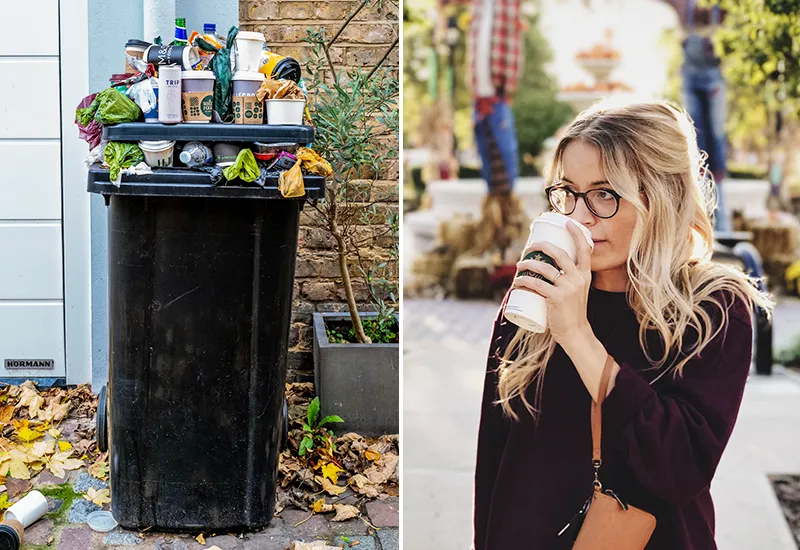
In the recycling process, the paper fibers are softened in water and then separated from foreign matter. But Unfortunately, the cardboard of disposable cups cannot be removed from the plastic coating. This is the reason why classic cardboard coffee-to-go cups cannot be recycled. Unfortunately, around 140,000 disposable to-go cups for hot drinks are consumed in Germany every hour.₂₁
The environmentally friendly reusable alternative are washable, reusable Coffee to go mug, such as this one*.
6. the collection rate of spent batteries in Germany is only just under 48 percent.
The collection rate is understood to be the Ratio of the mass of used batteries taken back in a calendar year to the average mass of batteries put into circulation in the calendar year in question and the two preceding calendar years. It amounted to 48.2 percent in 2021.₂₂
As they contain toxic heavy metals such as mercury, cadmium and lead and we need to protect ourselves and the environment from them, it is important to recover as much of the recyclable materials as possible. To do this, they must always be collected and recycled separately from unsorted municipal waste.
7. 100 percent of all sea turtles examined have plastic in their bodies
One in the magazine Global Change Biology published study showed that all of the more than 100 sea turtles examined of all seven species in the Pacific, Atlantic and Mediterranean had plastic in their gut. This recycling fact illustrates the extent of human Microplastics in the oceans or of the Plastic waste in the environment - and underlines why it is so important to separate waste correctly and recycle plastic as efficiently as possible.
Good to know: When people simply leave their garbage in public places instead of disposing of it at home, this is called Littering. You can find out more about this convenient phenomenon in the linked blog article.
8. there is a difference between "compostable" and "garden compostable".
Even if it is each by biodegradable products the two terms do not mean exactly the same thing in this respect, which is why I like to regard this information as a remarkable recycling fact.
In Germany and the EU, according to DIN EN 13432 products are considered compostable if they can be decomposed under industrial composting conditions, i.e. at high temperatures and with special microorganisms.
According to the standard NF T51-800:2015 certified products are considered garden compostable. This means that they decompose even under the relatively mild conditions of a private compost heap or public compost site. This means that they are biodegradable without the need for industrial processes.
9 The recycling rate for bulky waste in Germany is 57 percent
While the recycling rates for waste electrical and electronic equipment, glass, paper and biowaste in Germany are very good, the recycling rates for discarded bulky items of furniture from private households reveal a Great potential for improvement. The recycling rate for bulky waste is only 57 percent.₂₃
10. there are over 3000 recycling centers in Germany
At recycling and reusable material depots, for example, you can Construction waste, waste paper, glass, scrap metal, waste wood, electrical appliances, plastic waste or even green waste drop off. There are more than 3,000 recycling centers in Germany where you can dispose of your waste properly and have it recycled.
Using recycling statistics to change the world for the better
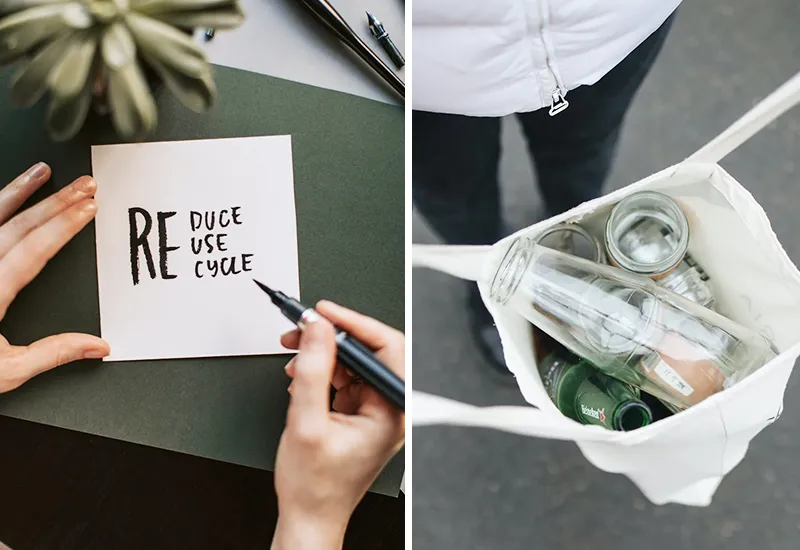
The statistics and facts presented in this article make it clear how important recycling is for our planet, our society and ultimately for our future. The recycling of waste and other raw materials plays a crucial role in overcoming the countless challenges of our time.
By producing less waste and using our Separate waste correctlywe make recycling easier - and protect our environment, the animal world, ourselves and not least the lives of our children and grandchildren.
"The greatest threat to our planet is the belief that someone else will save it."
Robert Swan (more at Environmental protection quotes)
At this point I would like to give you some further articles that are closely linked to recycling and may be of interest to you:
- Zero waste tips - making less waste in everyday life
- Earth Overload Day - What is it?
- Nudging - How people are guided towards sustainable behavior
- Urban mining - What is urban mining?
I very much hope that this collection of recycling statistics and facts has given you a new insight into the importance of recycling. Do you have any questions, suggestions or other figures and data that should not be missing here? Then I look forward to your comments.
Remain sustainable and appreciative of raw materials,

PS: Have you ever heard of the Upcycling heard? Find out how you can turn old items into new things and save natural resources in the next article.
References:
₁ https://www.umweltbundesamt.de/daten/ressourcen-abfall/verwertung-entsorgung-ausgewaehlter-abfallarten/kunststoffabfaelle
₂ https://www.nabu.de/umwelt-und-ressourcen/abfall-und-recycling/26205.html
₃ https://www.boell.de/de/plastikmuell
₄ https://de.statista.com/statistik/daten/studie/156544/umfrage/recyclingquote-von-papierverpackungen-in-deutschland-seit-1991
₅ https://www.cepi.org/wp-content/uploads/2021/07/WEB-PAGES_EPRC-Monitoring-Report-2020_20210716.pdf
₆ https://www.researchandmarkets.com/report/paper-recycling
₇ https://www.bmuv.de/themen/wasser-ressourcen-abfall/kreislaufwirtschaft/abfallarten-abfallstroeme/altglas
₈ https://www.recovery-worldwide.com/en/artikel/glass-recycling-current-market-trends-3248774.html
₉ https://www.alliedmarketresearch.com/recycled-glass-market
₁₀ https://www.bmuv.de/fileadmin/Daten_BMU/Pools/Broschueren/abfallwirtschaft_2023_bf.pdf
₁₁ https://de.statista.com/statistik/daten/studie/259779/umfrage/recyclinganteil-bei-der-produktion-ausgewaehlter-metalle-in-deutschland
₁₂ https://www.iea.org/data-and-statistics/charts/end-of-life-recycling-rates-for-selected-metals
₁₃ https://www.br.de/nachrichten/wissen/globaler-e-waste-monitor-2020-viel-mehr-elektroschrott-weltweit,S3ZvJab
₁₄ https://www.dw.com/de/elektromüll-recyceln/a-54000832
₁₅ https://de.statista.com/statistik/daten/studie/795745/umfrage/verteilung-der-verwendung-von-bekleidung-der-textilindustrie-weltweit
₁₆ https://www.bvse.de/themen/geschichte-des-textilrecycling/der-weg-der-altkleider-von-der-sammlung-zur-wiederverwendung.html
₁₇ https://www.diepresse.com/757421/umweltverschmutzung-recycling-in-der-antike
₁₈ https://de.statista.com/infografik/13203/anzahl-alt-handys-in-deutschen-haushalten
₁₉ https://www.bvse.de/gut-informiert-kunststoffrecycling/nachrichten-recycling/5000-recyclingkunststoffe-sparen-bis-zu-60-prozent-des-co2-von-neugranulat-ein-digitale-plattform-vereinfacht-handel-und-einsatz-von-recyclaten-2.html
₂₀ Jess French (2019): So much garbage, p. 6.
₂₁ https://www.bmuv.de/faq/wie-viele-einweg-becher-werden-jaehrlich-verbraucht-wie-viele-landen-davon-in-der-umwelt
₂₂ https://www.umweltbundesamt.de/daten/ressourcen-abfall/verwertung-entsorgung-ausgewaehlter-abfallarten/altbatterien#die-sammelquote-fur-geratebatterien-stieg-im-jahr-2021-auf-482-prozent
₂₃ https://de.statista.com/statistik/daten/studie/194573/umfrage/recyclingquote-von-abfall-in-deutschland

